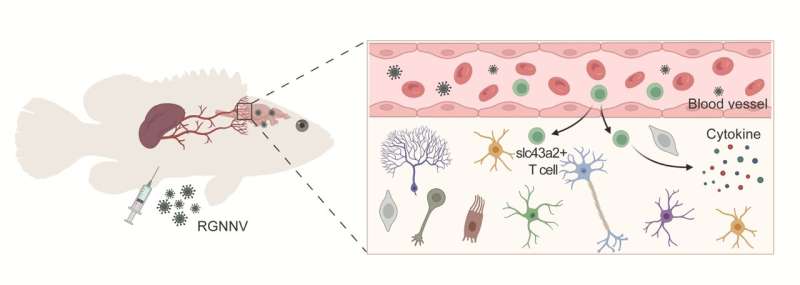This article has been reviewed according to Science X's editorial process and policies. Editors have highlighted the following attributes while ensuring the content's credibility:
fact-checked
peer-reviewed publication
trusted source
proofread
Research finds T cell subset significantly expands in spleen and brain after virus infection

It is currently unclear where T cells in the brains of teleosts originate from. While viewing the central nervous system (CNS) as immune privileged has been widely accepted, previous studies suggest that T cells residing in the thymus but not in the spleen of the teleost play an essential role in communicating with the peripheral organs.
A recent study published in the journal Science China Life Sciences was led by Prof. Qiwei Qin (College of Marine Sciences, South China Agricultural University) and Prof. Qiang Lin (CAS Key Laboratory of Tropical Marine Bio-Resources and Ecology, South China Sea Institute of Oceanology, Chinese Academy of Sciences).
In the research, Qing Wang, together with lab director Qiwei Qin, identified nine T cell subpopulations, and found that Slc43a2+T cell subsets significantly expanded in the spleen and brain after virus infection, suggests that Slc43a2+T cells in brain and spleen may be homologous.
Yali Liu and Jiang Han, together with lab director Qiang Lin, used the zebrafish model with spleen deficiency and found the absence of spleen resulted in the lack of Slc43a2+T cells in the brain, suggesting that Slc43a2+T cells in the brain came from the spleen tissue.
The team using single-cell transcriptomic analysis indicated that slc43a2+T cells mature and functionally differentiate within the spleen and then migrate into the brain to trigger an immune response. This study sheds light on a novel migratory pathway of T cells from the spleen to mediate the brain immune response to infection in fish.
More information: Qing Wang et al, Slc43a2+ T cell metastasis from spleen to brain in RGNNV infected teleost, Science China Life Sciences (2024). DOI: 10.1007/s11427-023-2473-x


















